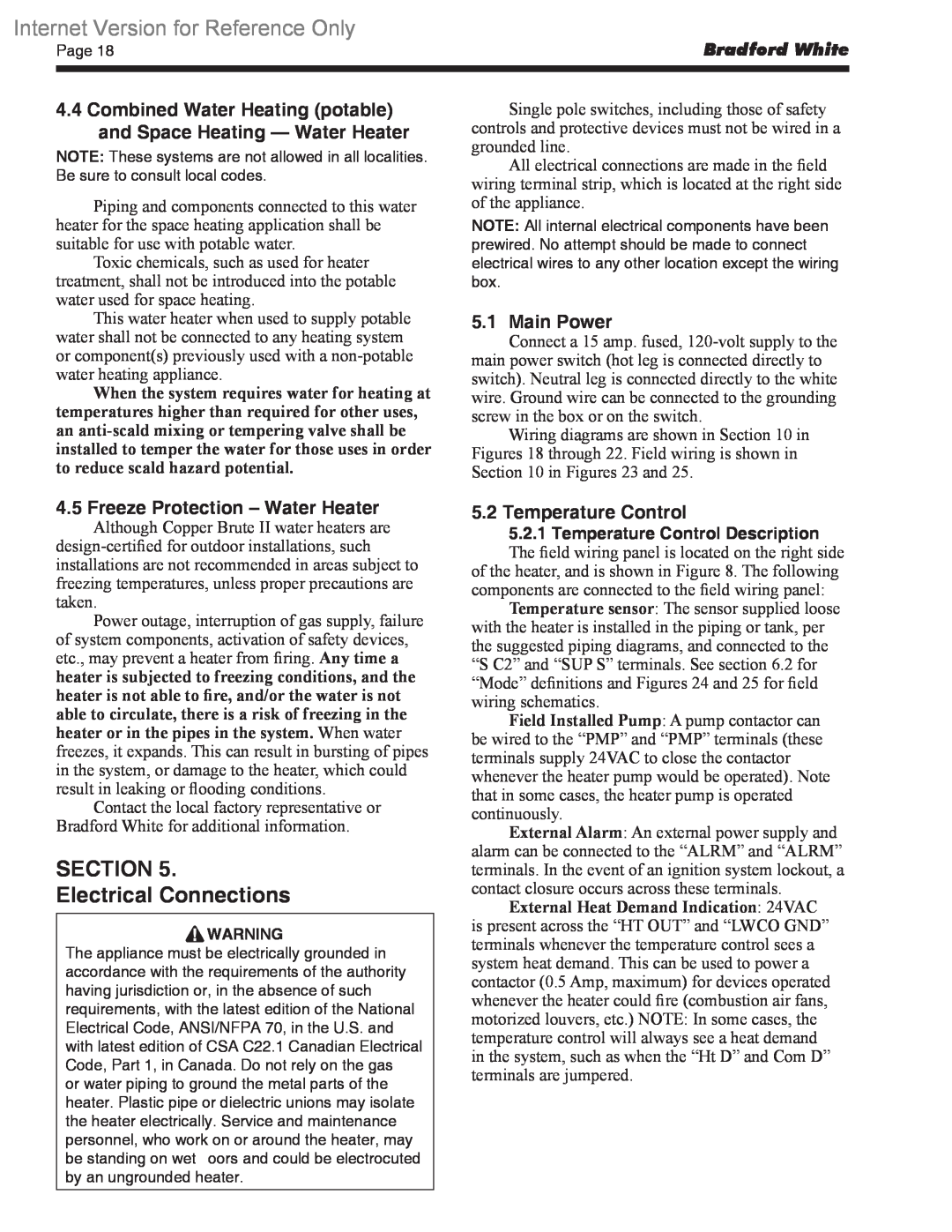
Internet Version for Reference Only
Page 18 | Bradford White |
|
|
|
|
4.4Combined Water Heating (potable) and Space Heating — Water Heater
NOTE: These systems are not allowed in all localities. Be sure to consult local codes.
Piping and components connected to this water heater for the space heating application shall be suitable for use with potable water.
Toxic chemicals, such as used for heater treatment, shall not be introduced into the potable water used for space heating.
This water heater when used to supply potable water shall not be connected to any heating system or component(s) previously used with a
When the system requires water for heating at temperatures higher than required for other uses, an
Single pole switches, including those of safety controls and protective devices must not be wired in a grounded line.
All electrical connections are made in the field wiring terminal strip, which is located at the right side of the appliance.
NOTE: All internal electrical components have been prewired. No attempt should be made to connect electrical wires to any other location except the wiring box.
5.1Main Power
Connect a 15 amp. fused,
main power switch (hot leg is connected directly to switch). Neutral leg is connected directly to the white wire. Ground wire can be connected to the grounding screw in the box or on the switch.
Wiring diagrams are shown in Section 10 in Figures 18 through 22. Field wiring is shown in Section 10 in Figures 23 and 25.
4.5Freeze Protection – Water Heater
Although Copper Brute II water heaters are
Power outage, interruption of gas supply, failure of system components, activation of safety devices, etc., may prevent a heater from firing. Any time a heater is subjected to freezing conditions, and the heater is not able to fire, and/or the water is not able to circulate, there is a risk of freezing in the heater or in the pipes in the system. When water freezes, it expands. This can result in bursting of pipes in the system, or damage to the heater, which could result in leaking or flooding conditions.
Contact the local factory representative or Bradford White for additional information.
SECTION 5.
Electrical Connections
![]() WARNING
WARNING
The appliance must be electrically grounded in accordance with the requirements of the authority having jurisdiction or, in the absence of such requirements, with the latest edition of the National Electrical Code, ANSI/NFPA 70, in the U.S. and with latest edition of CSA C22.1 Canadian Electrical Code, Part 1, in Canada. Do not rely on the gas
or water piping to ground the metal parts of the heater. Plastic pipe or dielectric unions may isolate the heater electrically. Service and maintenance personnel, who work on or around the heater, may be standing on wet floors and could be electrocuted by an ungrounded heater.
5.2 Temperature Control
5.2.1Temperature Control Description
The field wiring panel is located on the right side
of the heater, and is shown in Figure 8. The following components are connected to the field wiring panel:
Temperature sensor: The sensor supplied loose with the heater is installed in the piping or tank, per the suggested piping diagrams, and connected to the “S C2” and “SUP S” terminals. See section 6.2 for “Mode” definitions and Figures 24 and 25 for field wiring schematics.
Field Installed Pump: A pump contactor can be wired to the “PMP” and “PMP” terminals (these terminals supply 24VAC to close the contactor whenever the heater pump would be operated). Note that in some cases, the heater pump is operated continuously.
External Alarm: An external power supply and alarm can be connected to the “ALRM” and “ALRM” terminals. In the event of an ignition system lockout, a contact closure occurs across these terminals.
External Heat Demand Indication: 24VAC is present across the “HT OUT” and “LWCO GND” terminals whenever the temperature control sees a system heat demand. This can be used to power a contactor (0.5 Amp, maximum) for devices operated whenever the heater could fire (combustion air fans, motorized louvers, etc.) NOTE: In some cases, the temperature control will always see a heat demand in the system, such as when the “Ht D” and Com D” terminals are jumpered.
